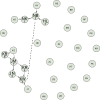Social network analysis shows direct evidence for social transmission of tool use in wild chimpanzees
- PMID: 25268798
- PMCID: PMC4181963
- DOI: 10.1371/journal.pbio.1001960
Social network analysis shows direct evidence for social transmission of tool use in wild chimpanzees
Abstract
Social network analysis methods have made it possible to test whether novel behaviors in animals spread through individual or social learning. To date, however, social network analysis of wild populations has been limited to static models that cannot precisely reflect the dynamics of learning, for instance, the impact of multiple observations across time. Here, we present a novel dynamic version of network analysis that is capable of capturing temporal aspects of acquisition--that is, how successive observations by an individual influence its acquisition of the novel behavior. We apply this model to studying the spread of two novel tool-use variants, "moss-sponging" and "leaf-sponge re-use," in the Sonso chimpanzee community of Budongo Forest, Uganda. Chimpanzees are widely considered the most "cultural" of all animal species, with 39 behaviors suspected as socially acquired, most of them in the domain of tool-use. The cultural hypothesis is supported by experimental data from captive chimpanzees and a range of observational data. However, for wild groups, there is still no direct experimental evidence for social learning, nor has there been any direct observation of social diffusion of behavioral innovations. Here, we tested both a static and a dynamic network model and found strong evidence that diffusion patterns of moss-sponging, but not leaf-sponge re-use, were significantly better explained by social than individual learning. The most conservative estimate of social transmission accounted for 85% of observed events, with an estimated 15-fold increase in learning rate for each time a novice observed an informed individual moss-sponging. We conclude that group-specific behavioral variants in wild chimpanzees can be socially learned, adding to the evidence that this prerequisite for culture originated in a common ancestor of great apes and humans, long before the advent of modern humans.
Conflict of interest statement
The authors have declared that no competing interests exist.
Figures


Comment in
-
Animal behaviour: Incipient tradition in wild chimpanzees.Nature. 2014 Oct 9;514(7521):178-9. doi: 10.1038/nature13759. Epub 2014 Oct 1. Nature. 2014. PMID: 25274304 No abstract available.
References
-
- Hoppitt W, Boogert NJ, Laland KN (2010) Detecting social transmission in networks. J Theor Biol 263: 544–555. - PubMed
-
- Dufour V, Sueur C, Whiten A, Buchanan-Smith HM (2011) The impact of moving to a novel environment on social networks, activity and wellbeing in two new world primates. Am J Primatol 73: 802–811. - PubMed
-
- Pinter-Wollman N, Hobson EA, Smith JE, Edelman AJ, Shizuka D, et al. (2013) The dynamics of animal social networks: analytical, conceptual, and theoretical advances. Behav Ecol 25 (2) 242–255.
-
- Wey T, Blumstein DT, Shen W, Jordán F (2008) Social network analysis of animal behaviour: a promising tool for the study of sociality. Anim Behav 75: 333–344.
Publication types
MeSH terms
Associated data
Grants and funding
LinkOut - more resources
Full Text Sources
Other Literature Sources

